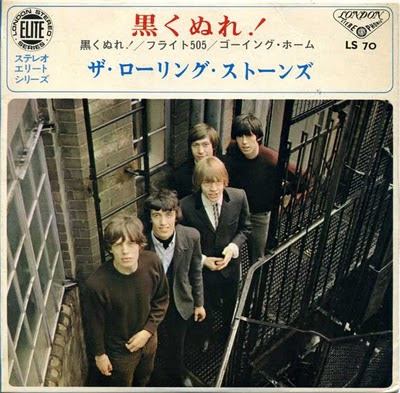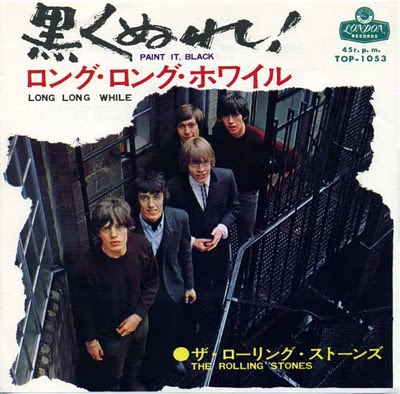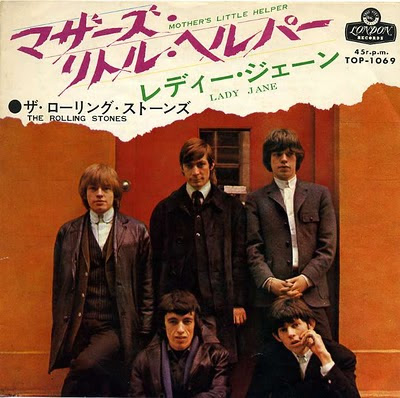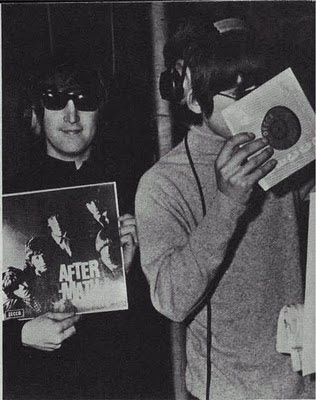The Rolling Stones - Vol. 5, Aftermath (JAPANESE Edition UK 1966)

Aftermath, first released in April 1966, was the fourth UK and sixth US studio album by "The Rolling Stones".
The album proved to be a major artistic breakthrough for "The Rolling Stones", being the first full-length release by the band to consist exclusively of "Mick Jagger"/"Keith Richards" compositions.
Aftermath was also the first "The Rolling Stones" album to be recorded entirely in the United States, at the legendary RCA Studios in Los Angeles, California at 6363 Sunset Boulevard, and the first album the band released in Stereo.
The album is also notable for its musical experimentation, with "Brian Jones" playing a variety of instruments which feature prominently in each track, including the sitar on "Paint It, Black", and the Appalachian dulcimer on "Lady Jane" and "I Am Waiting", marimba (African xylophone) on "Under My Thumb", and "Out of Time", harmonica on "High and Dry" and "Goin' Home" as well as guitar and keyboards.
To this day Aftermath remains a big fan favorite from the "Brian Jones" era.
 The Rolling Stones: "Paint It, Black"/"Flight 505"/"Goin' Home", London Records LS 70, EP Japan 1966
The Rolling Stones: "Paint It, Black"/"Flight 505"/"Goin' Home", London Records LS 70, EP Japan 1966As with all the "The Rolling Stones" pre-1967 LPs, different editions were released in the UK and the USA.
This was a common feature of British Pop albums at that time -- the same practice was applied to all Beatles albums prior to "Sgt. Pepper's Lonely Hearts Club Band"-- because UK albums typically did not include tracks that had already been released as singles.
 The Rolling Stones: "19th Nervous Breakdown" / "The Spider And The Fly", London TOP-1020, Japan 1966
The Rolling Stones: "19th Nervous Breakdown" / "The Spider And The Fly", London TOP-1020, Japan 1966The UK version of Aftermath was issued in April 1966 as a fourteen-track LP, and this is generally considered to be the definitive version. Issued between the non-LP single releases of "19th Nervous Breakdown" and "Paint It, Black", Aftermath was a major hit in the UK, spending eight weeks at #1 on the UK album chart.
 The Rolling Stones: "Paint It, Black" / "Long Long While", London TOP-1053, Japan 1966
The Rolling Stones: "Paint It, Black" / "Long Long While", London TOP-1053, Japan 1966The British version of Aftermath was released earlier than its American counterpart and had several differences beyond its cover design: it runs more than ten minutes longer, despite not having "Paint It, Black" on it (singles were usually kept separate from LPs in England in those days), and it has four additional songs — "Mother's Little Helper", which was left off the US album for release as a single; "Out of Time" in its full-length five-minute-36-second version, two minutes longer than the version of the song issued in America; "Take It Or Leave It", which eventually turned up on Flowers in the US; and "What To Do", which didn't surface in America until the release of "More Hot Rocks" more than six years later.
Additionally, the song lineup is different, "Goin' Home" closing side one instead of side two.
And the mixes used are different from the tracks that the two versions of the album do have in common — the UK album and CD used a much cleaner, quieter master that had a more discreet stereo sound, with wide separation in the two channels and the bass not centered as it in the US version.
Thus, one gets a more vivid impression of the instruments. It's also louder yet curiously, because of the cleaner sound, slightly less visceral in its overall impact, though the details in the playing revealed in the mixes may fascinate even casual listeners.
 The Rolling Stones: "Mother's Little Helper" / "Lady Jane", London TOP-1069, Japan 1966
The Rolling Stones: "Mother's Little Helper" / "Lady Jane", London TOP-1069, Japan 1966It's still a great album, though the difference in song lineup makes it a different record; "Mother's Little Helper" is one of the more in-your-face drug songs of the period, as well as being a potent statement about middle-class hypocrisy and political inconsistency, and "Out Of Time", "Take It Or Leave It" (which had been a hit for "The Searchers"), and "What To Do", if anything, add to the misogyny already on display in "Stupid Girl" and "Think", and "Out Of Time" adds to the florid sound of the album's Psychedelic component (and there's no good reason except for a plain oversight by the powers that be for the complete version of "Out Of Time" never having been released in America).
"The Rolling Stones" released "19th Nervous Breakdown" several months earlier as a non album song. This classic, frenetic rocker was terrific with a dense and layered sound supporting "Mick Jagger"'s vocal. It reached number two on the American charts and could have easily been included on Aftermath. Also the double sided single "Lady Jane" / "Mother's Little Helper" was released in the United States.
Most of the tunes are strong and this has to go down as containing "Brian Jones"' best work.
He plays several different instruments on this LP besides guitar. Most interesting is his heavy metal sounding sitar on "Paint It, Black".
 Brian Jones with sitar at Ready Steady Go, London 1966
Brian Jones with sitar at Ready Steady Go, London 1966Nobody up to this time had ever played a sitar as the lead instrument for a Hard Rock song, yet it turned out sounding so great that the song is still today considered one of "The Rolling Stones" all time best ever.
Aftermath was an instant commercial success in the United States, rising to number 2 on the Billboard chats and selling over one million copies. It would remain on the charts for 50 weeks.
 The critical consensus on Aftermath seems to be that it marked the point where "The Rolling Stones" really started to come into their own from a creative standpoint.
The critical consensus on Aftermath seems to be that it marked the point where "The Rolling Stones" really started to come into their own from a creative standpoint. All the songs were original and the band began to deviate from its Blues Rock roots both instrumentally and stylistically.
 John Lennon with an Aftermath copy during Revolver sessions, 1966
John Lennon with an Aftermath copy during Revolver sessions, 1966Most people also accept that these changes were instigated by the activities of other artists, primarily "The Beatles" as well as "Bob Dylan" and possibly "The Beach Boys".
To a certain extent, "The Rolling Stones" outdid "The Beatles" (but not "The Beach Boys") in terms of the sheer diversity of non-standard instrumentation. The only thing "Rubber Soul" had on it was the first appearance of "George Harrison"'s sitar and some maracas.
This time period saw "The Rolling Stones" use the marimba, sitar and dulcimer, as well as various pianos and keyboards. The result? Well we all know that "Under My Thumb" and "Paint It, Black" are great, and it's no surprise that "The Rolling Stones" could put together some hit singles. The real question is whether they were able to make a record as consistent, or artistically cohesive as "Rubber Soul" or "Pet Sounds". I appear to be in the minority in this view but I'd have to say that in this respect, they totally failed.
Unlike "The Beatles" or "The Beach Boys", their use of unusual instruments comes off as forced, inorganic and unnecessary.
"Lady Jane" is a good example of this. In "Norwegian Wood", "John Lennon" already had the basic melody worked out, and "George Harrison"'s use of the sitar on the track was a decision made to improve an already existing song.
"Lady Jane" sounds like a song that was built around the idea of playing a song a on a weird instrument, as the fact that it's played on a dulcimer is the only interesting thing about it.
 Brian Jones with dulcimer, 1966
Brian Jones with dulcimer, 1966And that's exactly what makes Aftermath so unique. It's a bunch of non-professionals that happen to have a good nose for Pop hooks, but are way too soaked in the Blues to adorn them with sitar and dulcimer, and have to resort to the good ol' Fuzzbox, the trusty old Blues harmonica and crappy guitar tuning instead.
The hooks on Aftermath are, indeed, exceedingly strong, but it is their combination with the regular stonesy grittiness that gives the album its outstanding flavour.
At least, that's how I view it. Too many people have complained that from 1966 to 1967 "The Rolling Stones" were nothing but a pallid imitation of "The Beatles"; I certainly prefer the 'original evil twin' description instead.
Granted, "Brian Jones" seemed to be aware of these limitations. His transformation on this record - even though he's never credited for any of the songs - is perhaps even more stunning, as it was he who'd been the original Blues purist in the band. Keith was the rocker, Mick the PR guy, and Brian the spiritual guru.
On Aftermath, though, it is "Brian Jones" who's responsible for dragging in both the sitar and the dulcimer (probably while the others weren't looking), in addition to marimbas and whatever else he's having out there - as if he just woke up one morning with the idea of 'blues just won't cut it anymore' stuck in his head and proceeded from there.
Unfortunately, "Brian Jones" seems to have been working in gusts and torrents: his presence ranges from essential to barely felt, and by the time Side 2 of the album rolls along, he's barely there, although, of course, this isn't quite the same 'barely there' as it'd be in a matter of just two years' time.
 The Rolling Stones 1966, photo courtesy Jerry Schatzberg(?)
The Rolling Stones 1966, photo courtesy Jerry Schatzberg(?)Still, it's a goddamn shame "Brian Jones" has never been given credit for "Paint It, Black" at least.
You only have to listen once to any of the live versions of the song available and compare it with the studio original to understand just how much it loses without the sitar.
Because, in fact, it's a very simple song, isn't it? It's essentially just one line, over and over again. The sitar is what gives it meaning: it's a mantra, and what is a mantra but a trance-inducing repetition? But then at the very heart of it is lodged a stunning hook, when they change keys midway through each verse and oops! the mantra suddenly becomes a furious Pop-Rocker.
And then, oops, a mantra once again.
And so on and on, until, towards the coda, it is finally and firmly stabilized as a mantra.
Omit the sitar - never mind that the playing is amateurish and sloppy, "Brian Jones" could never hope to get to be an instantaneous "Ravi Shankar" - and you just have the Rocker.
A pretty awesome Rocker, but no subtlety involved. "Brian Jones", for one, knew this, which is why he probably insisted upon bringing the sitar to the Ed Sullivan Show.
see also "The Rolling Stones - Vol. 4, Out Of Our Head" (JAPANESE Edition UK 1965),
"The Rolling Stones - Vol. 1, England's Newest Hitmakers" (JAPANESE Edition UK 1965),
"The Rolling Stones - Vol. 3, Now! (JAPANESE Edition UK 1965)"
"The Rolling Stones - Vol. 2, 12 X 5 (JAPANESE Edition UK 1965)"
"The Lost Rolling Stones Photographs: The Bob Bonis Archive, 1964-1966"
"Stones In Exile", DVD 2010
"Sympathy For The Devil", DVD 1968
"The Rolling Stones Rock and Roll Circus", DVD 1968
Subscribe to:
Post Comments
(
Atom
)







4 Comments :
Thank you for this! And what great detailed info. Hat's off!
-jrsfarm-
I totally agree with you about the fact that the Stones never achieved something at the level of Rubber Soul/Revolver/Pet Sounds. You're not alone ! And we are no that few !
They're one of my favorite bands ever!! I listen to them probably more than I should, but who cares!! Their music never gets old!!!!!!!!!
There are Sly Stone grooves, Philly soul, rockabilly, Rhythm & especially Blues, an upbeat Ray Charles routine, Motown referencing "Happy Together", Marvin Gaye laments and a jazzy Southern marching band to carry us home. That said, this has a modern, edgy sound, cleaning off all sleepiness, played tight and mean. Saadiq has no time for middlebrow revivals. He pursues the heart and social significance of the classics and in doing so produces one himself.
Post a Comment